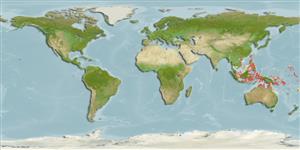>
Blenniiformes (Blennies) >
Blenniidae (Combtooth blennies) > Salariinae
Etymology: Salarias: Latin, salar, salaris = trout (Ref. 45335).
Eponymy: Dr Robert Arthur Patzner (d: 1945) is an Austrian marine biologist, ecologist and conservationist who is (2019) professor emeritus at the University of Salzburg’s Department of Ecology & Evolution. [...] (Ref. 128868), visit book page.
Environment: milieu / climate zone / depth range / distribution range
Ecologia
marinhas associadas(os) a recifes; intervalo de profundidade 0 - 5 m (Ref. 90102). Tropical
Western Central Pacific: Australia, Indonesia, Philippines.
Tamanho / Peso / Idade
Maturity: Lm ? range ? - ? cm
Max length : 5.5 cm TL macho/indeterminado; (Ref. 36661)
Descrição suscinta
Chaves de identificação | Morfologia | Morfometria
Espinhos dorsais (total) : 12; Raios dorsais (total) : 17 - 18; Espinhos anais: 2; Raios anais : 19. Body coloration with 8 pairs of irregular, olive-brown bars and numerous small white spots (particularly on anterior half), breast with large white spot (no defined dark margin), and 2 large dark spots on throat. Segmented caudal rays, 13, with middle 9 branched; supraorbital tentacle with slender base, tip bifid with secondary branches; palmate nape cirrus; nasal cirrus, simple lanceolate filament; upper and lower lip margins smooth; lacking an occipital crest; last anal ray and caudal peduncle connected by membrane; body depth at anal-fin origin 4.6-5.5 in SL (Ref. 90102).
Facultative air-breathing (Ref. 126274); Adults are found solitary on corals both live and dead ones (Ref. 90102). They graze on epilithic algae along with the accompanying detritus and sediment (Ref. 94105). Oviparous. Eggs are demersal and adhesive (Ref. 205), and are attached to the substrate via a filamentous, adhesive pad or pedestal (Ref. 94114). Larvae are planktonic, often found in shallow, coastal waters (Ref. 94114).
Ciclo de vida ou comportamento de acasalamento
Maturidade | Reprodução | Desova | Ovos | Fecundidade | Larvas
Oviparous, distinct pairing (Ref. 205).
Allen, G.R., 1997. The marine fishes of tropical Australia and south-east Asia. Western Australian Museum, Perth, Western Australia. 292 p. (Ref. 36661)
Status na Lista Vermelha da UICN (Ref. 130435: Version 2024-2)
Ameaça para os humanos
Harmless
Uso pelos humanos
Ferramentas
Relatórios especiais
Baixar XML
Fontes da internet
Estimates based on models
Preferred temperature (Ref.
123201): 26 - 29.3, mean 28.7 °C (based on 1621 cells).
Índice de diversidade filogenética (Ref.
82804): PD
50 = 0.5001 [Uniqueness, from 0.5 = low to 2.0 = high].
Bayesian length-weight: a=0.00776 (0.00356 - 0.01695), b=3.00 (2.81 - 3.19), in cm total length, based on LWR estimates for this (Sub)family-body shape (Ref.
93245).
Nível Trófico (Ref.
69278): 2.0 ±0.00 se; based on food items.
Resiliência (Ref.
120179): Elevada, tempo mínimo de duplicação da população menor que 15 meses (Preliminary K or Fecundity.).
Fishing Vulnerability (Ref.
59153): Low vulnerability (10 of 100).
